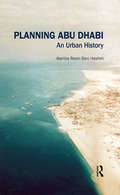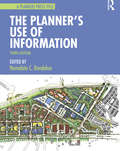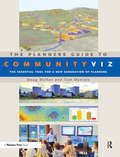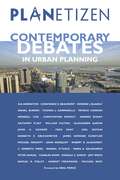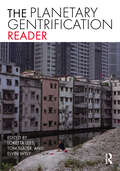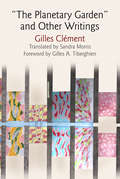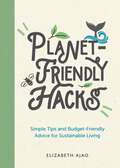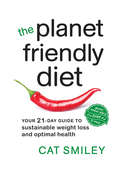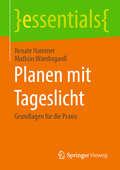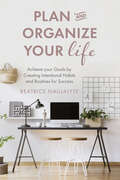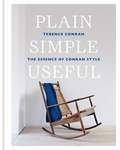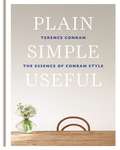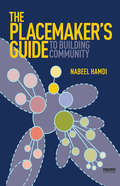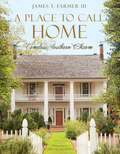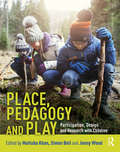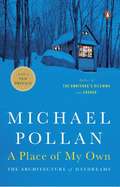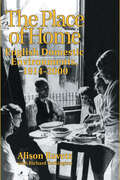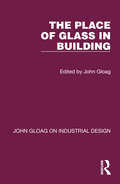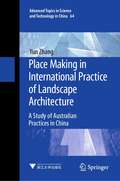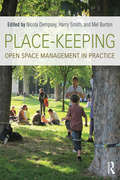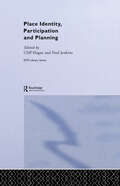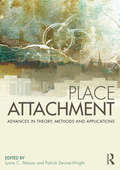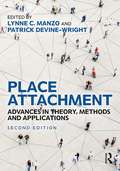- Table View
- List View
Planning Abu Dhabi: An Urban History (Planning, History and Environment Series)
by Alamira Reem Bani HashimAbu Dhabi’s urban development path contrasts sharply with its exuberant neighbour, Dubai. As Alamira Reem puts it, Abu Dhabi, capital of the United Arab Emirates since 1971, ‘has been quietly devising its own plans … to manifest its role and stature as a capital city’. Alamira Reem, a native Abu Dhabian and urban planner and researcher who has studied the emirate’s development for more than a decade, is uniquely placed to write its urban history. Following the introduction and description of Abu Dhabi’s early modern history, she focuses on three distinct periods dating from the discovery of oil in 1960, and coinciding with periods in power of the three rulers since then: Sheikh Shakhbut bin Sultan Al Nahyan (1960–1966), Sheikh Zayed bin Sultan Al Nahyan (1966–2004), and Sheikh Khalifa bin Zayed Al Nahyan (2004–). Based on archival research, key interviews and spatial mapping, she analyses the different approaches of each ruler to development; investigates the role of planning consultants, architects, developers, construction companies and government agencies; examines the emergence of comprehensive development plans and the policies underlying them; and assesses the effects of these many and varied influences on Abu Dhabi’s development. She concludes that, while much still needs to be done, Abu Dhabi’s progress towards becoming a global, sustainable city provides lessons for cities elsewhere.
The Planner's Use of Information
by Hemalata C. DandekarFor more than 35 years, planners have depended on The Planner's Use of Information to help them address their information needs. While the ability to manage complex information skillfully remains central to the practice of planning, the variety and quantity of information have ballooned in the last two decades. The methods of accessing and handling information––although often ultimately easier and faster––require new technical savvy. At the same time, planners themselves, and the constituents they serve, have changed. This completely revised and updated third edition of this popular book will serve the new generation of planners who work in a world where social media, cell phones, community-embedded development, and a changing population have revolutionized the practice of planning. Edited again by Hemalata C. Dandekar, with chapters by leading experts in data collection, analysis, presentation, and management, The Planner's Use of Information empowers practitioners to use and address the impacts of twenty-first-century technologies. The book offers a range of methods for addressing many kinds of information needs in myriad situations. It is an invaluable day-to-day resource for practicing planners and an ideal classroom text for courses in planning communication and analytical methods. Illustrations, real-life examples, cartoons, exercises, bibliographies, and lists of online resources enrich the text.
The Planners Guide to CommunityViz: The Essential Tool for a New Generation of Planning
by Doug WalkerWhat does the future look like? Planners wrestle with this question daily as they strive to bring a community's vision of itself to life, in all its complexity. Here is an authoritative and accessible guide to a tool that combines 3-D visualization, data analysis and scenario building to let planners and citizens see the future impacts of a plan or development. The Planners Guide to CommunityViz is the first book to explain how to support planning projects with CommunityViz, GIS-based software that planners around the world are using to help decision-makers, professionals, and the public visualize, analyze, and communicate about development proposals, future growth patterns, and the outcome of particular plans or developments. It shows the planner which tools and techniques to use and how to use them for maximum effectiveness on planning projects large and small. Full of practical examples and case studies, the book shows how CommunityViz can enliven the comprehensive planning process from visioning, to public participation, to values mapping, to build-out analysis. Chapters show how to use CommunityViz to analyze zoning regulations, calculate the costs of community services, and evaluate development proposals requiring design review. In addition, it is applicable to transportation planning, natural-resource planning, land-development suitability assessment, and urban economic development analysis.
Planner's Estimating Guide: Projecting Land-Use and Facility Needs
by Arthur NelsonThe United States faces enormous changes in the next 25 years. Arthur C. (Chris) Nelson starts this book with a few projections: The population will grow by one-third to 375 million. We will need 60 million new housing units to house these people. There will be 60 percent more jobs, requiring 50 billion additional square feet of nonresidential space. The bottom line is that half of all development in 2030 will have been built since 2000. Nelson estimates the cost of new construction alone to be at least $20 trillion. This book gives planning practitioners a powerful tool to help decide where to put this new development. It does not advocate one development scenario over another, but it revolutionizes the job of estimating land-use and facility needs. Planner's Estimating Guide offers easy-to-use formulas and worksheets that are formatted in an Excel workbook on CD-ROM and carefully explained in the text. They make it easy to figure future requirements for countless scenarios. The workbook and text deal with a 20-year planning horizon for a fictitious county, but both the time projection and scale are entirely adaptable to myriad local circumstances. The program allows you to gather a first impression of future land-use needs, and revise it to reflect local limitations. For example, if the landscape in question won't support the land-use estimations, change the assumptions in the workbook to devise new estimates. The workbook shows the implications of growth based on standard assumptions; you can change the assumptions as needed to reflect local conditions — including public input — to see how outcomes change. Use the workbook as a model for testing local sensitivities with respect to land supply constraints and changes in policy assumptions. The results won't tell you what to do, but will reveal the numerical implications of different scenarios. The book is written principally for practitioners, and also for planning students as a primary or supplementary text. Used creatively, the powerful tools in Planner's Estimating Guide will help you determine the numerical implications of an almost infinite number of future circumstances that may affect your community.
Planetizen's Contemporary Debates in Urban Planning
by Abhijeet Chavan Christian Peralta Christopher Steins Abhijeet PlanetizenPlanetizen's Contemporary Debates in Urban Planning is a fascinating review of major topics and issues discussed in the field of urban planning, assembled by editors at Planetizen, the leading source of news and information for the planning and development community on the web. The book brings together a wide range of editorial and discussion topics, coupled with commentary and overviews to create an enlightening record of the continuously evolving philosophy of building and managing cities. The book's contributors include the most well-known experts in the planning and design fields, among them James Howard Kunstler, Alex Garvin, Andres Duany, Joel Kotkin, and Wendell Cox. These and other prominent thinkers offer passionate debates and thought-provoking commentary on the most important and controversial topics in the field of urban planning and design: gentrification, eminent domain, the philosophical divide between the Smart Growth community, libertarians and New Urbanists, regional growth patterns, urban design trends, transportation systems, and reaction to disasters such as Katrina and 9/11 that changed the way we look at cities and security. Planetizen's Contemporary Debates in Urban Planning provides readers with a unique and accessible introduction to a broad array of ideas and perspectives. With the increasing awareness of the need for sound urban planning to ensure the economic, environmental, and social health of modern society, Planetizen's Contemporary Debates in Urban Planning gives professionals in the field and concerned citizens alike a deeper understanding of the critical, complex issues that continue to challenge urban planners, designers, and developers.
The Planetary Gentrification Reader
by Loretta Lees Tom Slater Elvin WylyGentrification is a global process that the United Nations now sees as a human rights issue. This new Planetary Gentrification Reader follows on from the editors’ 2010 volume, The Gentrification Reader, and provides a more longitudinal (backward and forward in time) and broader (turning away from Anglo-/Euro-American hegemony) sense of developments in gentrification studies over time and space, drawing on key readings that reflect the development of cutting-edge debates. Revisiting new debates over the histories of gentrification, thinking through comparative urbanism on gentrification, considering new waves and types of gentrification, and giving much more focus to resistance to gentrification, this is a stellar collection of writings on this critical issue. Like in their 2010 Reader, the editors, who are internationally renowned experts in the field, include insightful commentary and suggested further reading. The book is essential reading for students and researchers in urban studies, urban planning, human geography, sociology, and housing studies and for those seeking to fight this socially unjust process.
"The Planetary Garden" and Other Writings (Penn Studies in Landscape Architecture)
by Gilles ClémentCelebrated landscape architect Gilles Clément may be best known for his public parks in Paris, including the Parc André Citroën and the garden of the Musée du Quai Branly, but he describes himself as a gardener. To care for and cultivate a plot of land, a capable gardener must observe in order to act and work with, rather than against, the natural ecosystem of the garden. In this sense, he suggests, we should think of the entire planet as a garden, and ourselves as its keepers, responsible for the care of its complexity and diversity of life."The Planetary Garden" is an environmental manifesto that outlines Clément's interpretation of the laws that govern the natural world and the principles that should guide our stewardship of the global garden of Earth. These are among the tenets of a humanist ecology, which posits that the natural world and humankind cannot be understood as separate from one another. This philosophy forms a thread that is woven through the accompanying essays of this volume: "Life, Constantly Inventive: Reflections of a Humanist Ecologist" and "The Wisdom of the Gardener." Brought together and translated into English for the first time, these three texts make a powerful statement about the nature of the world and humanity's place within it.
Planet-Friendly Hacks: Simple Tips and Budget-Friendly Advice for Sustainable Living
by Elizabeth AjaoThis handy guide is brimming with quick tips, life hacks and budget-friendly tricks to help you reduce your carbon footprint and live more sustainablyAn eco-friendly lifestyle is expensive and time-consuming, right? Wrong! There are countless ways to make green choices that don’t take a toll on your time, your bank balance or the planet.This book is your one-stop guide to living a more sustainable lifestyle. Whether you need tips on conserving energy or reducing food waste, or you want to give your home a makeover without impacting the planet, these pages include everything you need to get started. You will find:Clever life hacks to make reducing your carbon footprint that bit easierSimple tips to help you make planet-friendly choices in everyday lifeSmart advice for eco-living on a budgetInspiration for eco-friendly crafts and DIY projectsIt’s more important than ever to do our bit for the environment, and Planet-Friendly Hacks will help you live life to the full without costing the earth.
The Planet Friendly Diet
by Cat SmileyWould you like to lose weight, feel great, and minimize the impact of your eating habits on the environment? The Planet Friendly Diet is a unique, all-inclusive blueprint for a greener lifestyle based on responsible dietary choices. Jump start your journey to optimum health with the all-inclusive twenty-one day meal plan, and then apply the information in the accompanying nutrition guide to transform short-term success into long-term, sustainable results.Leading body-transformation expert and former professional skier Cat Smiley shares her simple step-by-step program for a complete detox and reboot. The diet is meat, dairy, wheat and gluten-free, and comes with a weekly shopping list to ensure zero-waste. All single-portion recipes: Use fresh, every day ingredients Cost less than $5.00 Are under 500 calories Take no more than twenty minutes to prepareWhether you want to give your eating patterns a complete makeover or just kick start a change towards a healthier life, The Planet Friendly Diet will motivate, educate and empower you. Fully-illustrated with mouthwatering images of each internationally inspired recipe, it's like having your very own nutrition coach and personal chef. And not only will yopu lose weight, get fit, and feel great - you'll be contributing to a wider humanitarian cause. Cat Smiley is an award-winning body transformation specialist and owner of Canada's premiere weight-loss retreat for women, Whistler Fitness Vacations. A former world-class skier, she is a philanthropist, nutritionist, and master trainer.
Planen mit Tageslicht: Grundlagen für die Praxis (essentials)
by Renate Hammer Mathias WambsganßNeue Erkenntnisse zur Wichtigkeit ausreichender Tageslichtversorgung im Innenraum haben planungsrelevante Änderungen normativer Vorgaben nach sich gezogen. Renate Hammer und Mathias Wambsganß veranschaulichen die neuen Anforderungen und erläutern die Möglichkeiten zur planerischen Umsetzung. Die Autoren klären, wann Tageslichtversorgung und Besonnung als ausreichend gelten, welche Qualitäten die Sichtverbindung nach außen erfüllen muss und wie Blendung durch Tageslicht zu begrenzen ist. Angaben zur melanopischen Wirkungsweise von Tageslicht bieten einen Einstieg in den planerischen Umgang mit nicht-visuellen Kriterien. Ein weiteres Kapitel zeigt die Schnittstellen mit anderen Aspekten der Bauplanung.Die Autoren:Dr. Renate Hammer studierte Architektur, Solararchitektur und Philosophie in Wien und Krems sowie Urban Engineering in Tokio. 2015 gründete sie das Institute of Building Research & Innovation. Sie unterrichtet einschlägig an der Kunstuniversität Linz und der FH Campus Wien. Prof. Mathias Wambsganß studierte Architektur an der Universität Karlsruhe (TH). 2014 gründete er das Büro „3lpi lichtplaner“ in München. Er ist langjähriges Mitglied im Vorstand der LiTG e.V. und wurde 2007 als Professor an die TH Rosenheim berufen.
Plan and Organize Your Life: Achieve your Goals by Creating Intentional Habits and Routines for Success
by Beatrice NaujalyteAchieve Your Personal Goals with Organization and Good Habits#1 New Release in Crafts, Hobbies & Home; Organizational Learning; Time Management; and Business Project ManagementLearn about how to get more out of life, reach your personal goals, develop good habits, and create meaningful work from YouTube, podcast, and Instagram star Beatrice Naujalyte.Start planning for success.Plan and Organize Your Life is a comprehensive and interactive “planning bible,” packed with proven advice on how to organize your life, create new habits, and how to work your way towards true self-improvement and personal growth.Achieve your personal goals. In Plan and Organize Your Life, author Beatrice Naujalyte introduces us to the four pillars of an intentional life: planning, organization, productivity, and routines. With simple tools, such as a day planner, you’ll be able to master effective note taking and utilize minimalism in your workspace and homelife.Design a system that works for you. This book is the ultimate guide to developing a planning system to effectively execute your personal goals daily, weekly, monthly, and yearly. Whether you have professional, personal, or creative planning to do, this book helps you accomplish your personal goals, big or small, by creating new habits and setting realistic goals.Perfect for everyday use, Plan and Organize Your Life is packed with:Tips and prompts on organization for your everyday successTime and task management tools to help you reach personal goalsProductivity tips for personal growth and forming good habitsIf you enjoyed books like Beautifully Organized at Work, Habits, or The Lazy Genius Way, you’ll love Plan and Organize Your Life.
Plain Simple Useful: The Essence of Conran Style
by Sir Terence Conran'A handsome yet joyful manual for easy, stylish living.' - Architectural DigestTerence Conran always believed that objects - and surroundings - that are plain, simple and useful are the key to easy living. By being practical and performing well over time, they are as much the antidote to superficial styling as they are to the shoddy and second-rate. Applied to the home as a whole, this discerning approach results in interiors that are effortlessly stylish, confident and timeless, with plenty of room for the expression of personal taste. Plain Simple Useful is organized according to the main activities that take place at home. Inspirational interiors, many of which were Conran's own, provide all the guidance you need to tailor-make your own storage. The book also features iconic examples of classic designs that will enhance any home, as well as a peek behind the closed doors of those well-ordered cupboards, larders and other stowing spaces that contribute so much to easy living.This updated edition of the book features a new chapter on plain, simple, useful style outdoors with elegant contemporary ideas for eating and relaxing spaces outside.
Plain Simple Useful: The Essence Of Conran Style
by Terence ConranTerence Conran has always believed that objects - and surroundings - that are plain, simple and useful are the key to easy living. By being practical and performing well over time, they are as much the antidote to superficial styling as they are to the shoddy and second-rate. Applied to the home as a whole, this discerning approach results in interiors that are effortlessly stylish, confident and timeless, with plenty of room for the expression of personal taste.Plain Simple Useful is organized according to the main activities that take place at home. Inspirational interiors, many of which are Conran's own, and a number of projects designed by him exclusively for this book, provide all the guidance you need to tailor-make your own storage. The book also features iconic examples of classic designs that will enhance any home, as well as a peek behind the closed doors of those well-ordered cupboards, larders and other stowing spaces that contribute so much to easy living.
Placing Nature: Culture And Landscape Ecology
by Joan Nassauer Chris FaustLandscape ecology is a widely influential approach to looking at ecological function at the scale of landscapes, and accepting that human beings powerfully affect landscape pattern and function. It goes beyond investigation of pristine environments to consider ecological questions that are raised by patterns of farming, forestry, towns, and cities.Placing Nature is a groundbreaking volume in the field of landscape ecology, the result of collaborative work among experts in ecology, philosophy, art, literature, geography, landscape architecture, and history. Contributors asked each other: What is our appropriate role in nature? How are assumptions of Western culture and ingrained traditions placed in a new context of ecological knowledge? In this book, they consider the goals and strategies needed to bring human-dominated landscapes into intentional relationships with nature, articulating widely varied approaches to the task.In the essays: novelist Jane Smiley, ecologist Eville Gorham, and historian Curt Meine each examine the urgent realities of fitting together ecological function and culture philosopher Marcia Eaton and landscape architect Joan Nassauer each suggest ways to use the culture of nature to bring ecological health into settled landscapes urban geographer Judith Martin and urban historian Sam Bass Warner, geographer and landscape architect Deborah Karasov, and ecologist William Romme each explore the dynamics of land development decisions for their landscape ecological effects artist Chris Faust's photographs juxtapose the crass and mundane details of land use with the poetic power of ecological pattern.Every possible future landscape is the embodiment of some human choice. Placing Nature provides important insight for those who make such choices -- ecologists, ecosystem managers, watershed managers, conservation biologists, land developers, designers, planners -- and for all who wish to promote the ecological health of their communities.
The Placemaker's Guide to Building Community (Earthscan Tools For Community Planning Ser.)
by Nabeel HamdiFrom the author of Small Change comes this engaging guide to placemaking, packed with practical skills and tools that architects, planners, urban designers and other built environment specialists need in order to engage effectively with development work in any context. Drawing on four decades of practical and teaching experience, the author offers fresh insight into the complexities faced by practitioners when working to improve the communities, lives and livelihoods of people the world over. The book shows how these complexities are a context for, rather than a barrier to, creative work. The book also critiques the single vision top down approach to design and planning. Using examples of successful professional practice across Europe, the US, Africa, Latin America and post-tsunami Asia, the author demonstrates how good policy can derive from good practices when reasoned backwards, as well as how plans can emerge in practice without a preponderance of planning. Reasoning backwards is shown to be a more effective and inclusive way of planning forwards with significant improvements to the quality of process and place. The book also offers a variety of methods and tools for analyzing the issues, engaging with communities and other stakeholders for design and settlement planning and for improving the skills of all involved in placemaking. Ultimately the book serves as an inspiring guide, and a distillation of decades of practical wisdom and experience. The resulting practical handbook is for all those involved in doing, learning and teaching placemaking and urban development world-wide.
A Place to Call Home: Timeless Southern Charm
by James T. Farmer IIIThe acclaimed interior designer combines rich tradition with modern sensibilities in this beautifully photographed book of homes across the deep South. James Farmer&’s design firm works with clients across the South who want to turn their houses into homes. Now Farmer takes readers on a guided tour of eleven home projects—from makeovers to remodels and new construction—as he brings together a cultivated mix of high and low, storied and new, collected and found; presenting them all as a thoughtfully exhibited array of taste, style, good architecture, and interior comfort. Woven alongside beautiful photography of interiors and exteriors are personal stories James shares about living in the South, the people in his life, and how he fell in love with home design. A Place to Call Home is a beautiful book to inspire Southern style at home―infusing the new with antique, vintage, and heirloom pieces.
Place, Pedagogy and Play: Participation, Design and Research with Children
by Matluba KhanPlace, Pedagogy and Play connects landscape architecture with education, psychology, public health and planning. Over the course of thirteen chapters it examines how design and research of places can be approached through multiple lenses – of pedagogy and play and how children, as competent social agents, are engaged in the process of designing their own spaces – and brings a global perspective to the debate around child-friendly environments. Despite growing evidence of the benefits of nature for health, wellbeing, play and learning, children are increasingly spending more time indoors. Indeed, new policy ideas and public campaigns suggest how children can become better connected with nature, yet linking outdoor space to pedagogy is largely overlooked in research. By focusing on three themes within these debates, place and play; place and pedagogy; and place and participation, this book explores a variety of angles to show that best practice requires dialogue between research disciplines, designers, educationists and psychologists, and a move beyond seeing the spaces children inhabit as the domain only of childhood professionals. Through illustrated case studies this book presents a wider picture of the state of childhood today, and offers practical solutions and further research avenues that promote a more holistic and internationally focused perspective on place, pedagogy and play for built-environment professionals. Chapter 12 of this book is freely available as a downloadable Open Access PDF under a Creative Commons Attribution-Non Commercial-No Derivatives 4.0 license.
A Place of My Own: The Architecture of Daydreams
by Michael PollanMichael Pollan's unmatched ability to draw lines of connection between our everyday experiences- whether eating, gardening, or building-and the natural world has been the basis for the popular success of his many works of nonfiction, including the genre-defining bestsellers The Omnivore's Dilemma and In Defense of Food. With this updated edition of his earlier book A Place of My Own, readers can revisit the inspired, intelligent, and often hilarious story of Pollan's realization of a room of his own-a small, wooden hut, his "shelter for daydreams"-built with his admittedly unhandy hands. Inspired by both Thoreau and Mr. Blandings, A Place of My Own not only works to convey the history and meaning of all human building, it also marks the connections between our bodies, our minds, and the natural world.
The Place of Home: English domestic environments, 1914-2000 (Planning, History and Environment Series)
by Alison Ravetz Professor Alison Ravetz R. TurkingtonA comprehensive and in-depth history of the 20th century English home, how it has been created, and how it works for people. It focuses on the various influences bearing on the development of domestic space since 1914 and covers both design and housing policy. Current debates from participation to co-operative housing are examined and several themes not previously brought together are linked, e.g. urban development/house design; technology at home/women and home; social meaning of home.
The Place of Glass in Building (John Gloag On Industrial Design Ser.)
by John GloagOriginally published in 1943, The Place of Glass in Building is a comprehensive and compact survey of the structural uses of glass in 20th Century architecture. It gives the facts about the physical properties, the possibilities and the limitations of the glass in common use. It also deals with the attributes of specialised and decorative glass and provides detailed descriptions of the principal types which were manufactured in the UK. Intended for architectural students it may also be of interest to architects, for it is a condensed survey of the progress that has been made in this structural and decorative material.
Place Making in International Practice of Landscape Architecture: A Study of Australian Practices in China (Advanced Topics in Science and Technology in China #64)
by Yun ZhangThis book explores international practice in landscape architecture, focusing on the provision of services from Australia to China during China’s contemporary urbanization and Australian landscape architects’ approaches to place. Landscape architectural practice requires planners and designers to have a deep understanding of local culture, site characteristics, craftsmanship and even project procedures that are often intangible. How to acquire the above local knowledge has become a major challenge for international teams. Through the survey of the practice of Australian landscape practices in China and the case study of Li Lake planning and design project, this book reveals the process and difficulties of landscape planning and design as a transnational practice, as well as its special value as a way of cross-cultural fertilization. This book is intended for students, practitioners and researchers in the fields of landscape architecture, architecture and urban planning.
Place-Keeping: Open Space Management in Practice
by Harry Smith Nicola Dempsey Mel BurtonPlace-Keeping presents the latest research and practice on place-keeping – that is, the long-term management of public and private open spaces – from around Europe and the rest of the world. There has long been a focus in urban landscape planning and urban design on the creation of high-quality public spaces, or place-making. This is supported by a growing body of research which shows how high-quality public spaces are economically and socially beneficial for local communities and contribute positively to residents’ quality of life and wellbeing. However, while large amounts of capital are spent on the creation of open spaces, little thought is given to, and insufficient resources made available for, the long-term maintenance and management of public spaces, or place-keeping. Without place-keeping, public spaces can fall into a downward spiral of disrepair where anti-social behaviour can emerge and residents may feel unsafe and choose to use other spaces. The economic and social costs of restoring such spaces can therefore be considerable where place-keeping does not occur. Place-Keeping also provides an accessible presentation of the outputs of a major European Union-funded project MP4: Making Places Profitable, Public and Private Open Spaces which further extends the knowledge and debate on long-term management of public and private spaces. It will be an invaluable resource for students, academics and practitioners seeking critical but practical guidance on the long-term management of public and private spaces in a range of contexts.
Place Identity, Participation and Planning (RTPI Library Series #Vol. 7)
by Paul Jenkins Cliff HagueThe central concern of this book is place identity, and its representation and manipulation through planning. Place identity is of growing international concern, both in planning practice and in academic work. The issue is important to practitioners because of the impact of globalisation on notions of place. This book includes comparisons between Norway, the Netherlands, Sweden and Scotland, focusing strongly on the question of how different spatial planning systems and practices are currently conceiving and affecting issues of place identity.
Place Attachment: Advances in Theory, Methods and Applications
by Lynne C. Manzo Patrick Devine-WrightRecipient of the 2014 EDRA Achievement Award. Place attachments are emotional bonds that form between people and their physical surroundings. These connections are a powerful aspect of human life that inform our sense of identity, create meaning in our lives, facilitate community and influence action. Place attachments have bearing on such diverse issues as rootedness and belonging, placemaking and displacement, mobility and migration, intergroup conflict, civic engagement, social housing and urban redevelopment, natural resource management and global climate change. In this multidisciplinary book, Manzo and Devine-Wright draw together the latest thinking by leading scholars from around the globe, capturing important advancements in three areas: theory, methods and application. In a wide range of conceptual and applied ways, the authors critically review and challenge contemporary knowledge, identify significant advances and point to areas for future research. This volume offers the most current understandings about place attachment, a critical concept for the environmental social sciences and placemaking professions.
Place Attachment: Advances in Theory, Methods and Applications
by Lynne C. Manzo Patrick Devine-WrightFollowing on from the ground-breaking first edition, which received the 2014 EDRA Achievement Award, this fully updated text includes new chapters on current issues in the built environment, such as GIS and mapping, climate change, and qualitative approaches. Place attachments are powerful emotional bonds that form between people and their physical surroundings. They inform our sense of identity, create meaning in our lives, facilitate community, and influence action. Place attachments have bearing on such diverse issues as rootedness and belonging, placemaking and displacement, mobility and migration, intergroup conflict, civic engagement, social housing and urban redevelopment, natural resource management, and global climate change. In this multidisciplinary book, Manzo and Devine-Wright draw together the latest thinking by leading scholars from around the globe, including contributions from scholars such as Daniel Williams, Mindy Fullilove, Randy Hester, and David Seamon, to capture significant advancements in three main areas: theory, methods, and applications. Over the course of fifteen chapters, using a wide range of conceptual and applied methods, the authors critically review and challenge contemporary knowledge, identify significant advances, and point to areas for future research. This important volume offers the most current understandings about place attachment, a critical concept for the environmental social sciences and placemaking professions.
